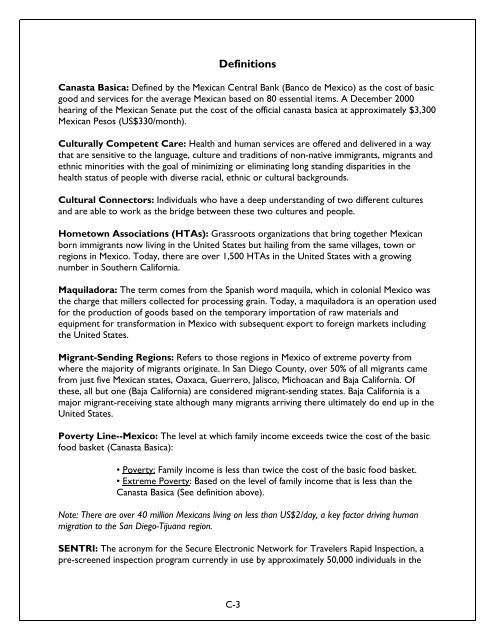Blurred Borders - International Community Foundation
Blurred Borders - International Community Foundation
Blurred Borders - International Community Foundation
Create successful ePaper yourself
Turn your PDF publications into a flip-book with our unique Google optimized e-Paper software.
Definitions<br />
Canasta Basica: Defined by the Mexican Central Bank (Banco de Mexico) as the cost of basic<br />
good and services for the average Mexican based on 80 essential items. A December 2000<br />
hearing of the Mexican Senate put the cost of the official canasta basica at approximately $3,300<br />
Mexican Pesos (US$330/month).<br />
Culturally Competent Care: Health and human services are offered and delivered in a way<br />
that are sensitive to the language, culture and traditions of non-native immigrants, migrants and<br />
ethnic minorities with the goal of minimizing or eliminating long standing disparities in the<br />
health status of people with diverse racial, ethnic or cultural backgrounds.<br />
Cultural Connectors: Individuals who have a deep understanding of two different cultures<br />
and are able to work as the bridge between these two cultures and people.<br />
Hometown Associations (HTAs): Grassroots organizations that bring together Mexican<br />
born immigrants now living in the United States but hailing from the same villages, town or<br />
regions in Mexico. Today, there are over 1,500 HTAs in the United States with a growing<br />
number in Southern California.<br />
Maquiladora: The term comes from the Spanish word maquila, which in colonial Mexico was<br />
the charge that millers collected for processing grain. Today, a maquiladora is an operation used<br />
for the production of goods based on the temporary importation of raw materials and<br />
equipment for transformation in Mexico with subsequent export to foreign markets including<br />
the United States.<br />
Migrant-Sending Regions: Refers to those regions in Mexico of extreme poverty from<br />
where the majority of migrants originate. In San Diego County, over 50% of all migrants came<br />
from just five Mexican states, Oaxaca, Guerrero, Jalisco, Michoacan and Baja California. Of<br />
these, all but one (Baja California) are considered migrant-sending states. Baja California is a<br />
major migrant-receiving state although many migrants arriving there ultimately do end up in the<br />
United States.<br />
Poverty Line--Mexico: The level at which family income exceeds twice the cost of the basic<br />
food basket (Canasta Basica):<br />
• Poverty: Family income is less than twice the cost of the basic food basket.<br />
• Extreme Poverty: Based on the level of family income that is less than the<br />
Canasta Basica (See definition above).<br />
Note: There are over 40 million Mexicans living on less than US$2/day, a key factor driving human<br />
migration to the San Diego-Tijuana region.<br />
SENTRI: The acronym for the Secure Electronic Network for Travelers Rapid Inspection, a<br />
pre-screened inspection program currently in use by approximately 50,000 individuals in the<br />
C-3















